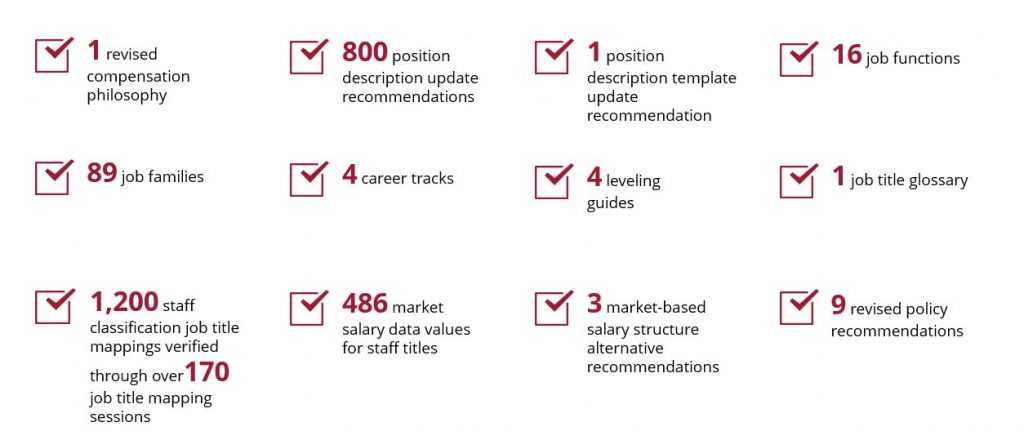InfoClassification and Compensation Implementation
The Classification and Compensation implementation is foundational to the University’s mission to advance the intellectual and social condition of the people of the state, the nation and the world through the creation, translation and dissemination of knowledge with an emphasis on quality programs in the areas of teaching, research and service.
Background
In 2019, HReimagined was launched to bring together a cross-section of stakeholders from across the University to design a set of recommendations for enhancing our HR strategies, structures, services, programs and systems. The team was charged with identifying HR best practices across higher education, reimagining our HR service delivery model and implementing the necessary changes.
One key area identified for review was the classification and compensation structure, which was last updated in 1995. Addressing the outdated structure became a top priority for HR. In partnership with UA’s Office of Counsel and Deloitte Consulting we spent the last year dedicated to better understanding the current market for staff positions and how UA compares.
The overarching objective has been to develop a classification and compensation structure that contributes to an exceptional work environment that attracts and retains the best talent.
Project Goals
- Develop a new structure of job classifications for all staff positions.
- Develop a new structure of pay grades for all staff positions.
- Align job titles more accurately to reflect the responsibilities of the position and the market.
- Provide more consistency in positions and pay across campus and relative to the market.
- Use data to better align compensation with the current market.
Key Points
- No UA employee saw their pay reduced as part of this plan.
- No positions were cut as part of the plan.
- The system is a market-based structure focused on improving salary competitiveness overall.
- Job titles will be more accurately aligned to responsibilities and to the job market.
- The system will create consistency in positions and pay across campus and relative to the market.
- Changes are based on responsibilities defined in documented job descriptions, not an individual’s performance or longevity in a role.
- Position descriptions were updated prior to last spring to be used in the new performance management system. Additional position descriptions were updated during the project.
- New pay ranges are a more accurate reflection of the market and will provide greater flexibility on competitive salary offers for both recruiting and retaining staff.
- Some compression issues were created by the first phase of the implementation, and not all identified compensation needs will be met this first year.
- Compression and other needs will be addressed in future phases as funding is available through the annual budgeting process.
“This updated staff plan is welcome and necessary as UA adapts to compete with the external market. After extensive review and analysis with our consultant partner and over 170 meetings with college and divisional leaders to gain their perspectives and input, we created the new staff position classification and compensation structure that will help us continue to retain and attract top talent.”
-Senior Associate Vice President & Chief Human Resources Officer Susan Norton
Schedule
Late November: Campus community is informed about updates to the Classification & Compensation structure through an email message and a campus announcement.
December: All recommendations are finalized and sent to administration for review.
January: Manager training conducted orienting managers to new structure.
Late January/Early February: Staff employees, who are employed at UA as of January 15th will receive a letter specifying their job classification/job title and compensation.
February: Any compensation changes are included in February paychecks.
February – June: Planning for the next phase of salary adjustments, taking into account funding availability and Board of Trustees required approvals.
Key Accomplishments

